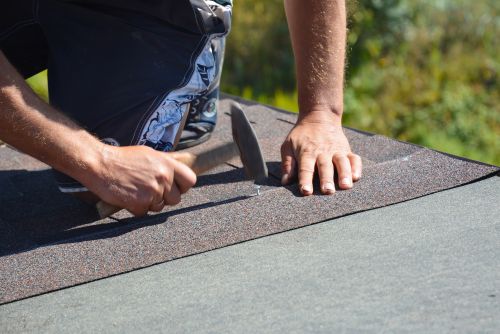When it comes to replacing a roof, timing is everything. As someone who has always had a subconscious desire for innovation, I understand the importance of staying ahead of the curve and making smart decisions. That's why I'm here to share with you the best time of year to replace your roof.
By taking advantage of the right season, you can ensure that your new roof not only looks great but also stands the test of time.
So let's dive in and discover what time of year is best to replace a roof that will leave your neighbors in awe.
Replace your roof in the spring to enjoy the warmer weather without leaks or damage. Spring is ideal for roof replacement due to mild temperatures and favorable weather. Spring brings a more stable climate for roofing projects, ending harsh winter storms. The moderate temperatures help contractors work without problems from heat or cold.
Spring is drier, reducing the chance of rain interrupting your roof replacement project. This reduces weather delays, allowing your contractor to finish the job on time.
Spring roof replacement prepares your roof for summer storms. By preparing for this important task, you'll rest easy knowing your home is protected from leaks and water damage.
Spring roof replacement lets you fix problems before summer heat and humidity worsen them. You can avoid further damage by detecting and fixing issues early in the spring. This proactive approach extends the life of your new roof and reduces repair and replacement costs.
Spring is ideal for roof replacement. The milder temperatures and more predictable weather make this crucial task easier. So why delay? Use this opportunity to improve your home's weatherproofing.

Winter is a good time to replace your roof. Winter is a good time to replace a roof for several reasons, despite appearances.
1. Winter weather can highlight existing roof damage: The harsh conditions of winter, such as heavy snowfall and freezing temperatures, can exacerbate any existing issues with your roof. By getting a replacement during this season, you can address these problems before they worsen and potentially cause significant damage to your home.
2. Availability of roofing contractors: Since winter is considered the off-season for many roofing contractors, you may have better luck scheduling your roof replacement during this time. With fewer projects to handle, contractors are more likely to have greater availability and be able to complete the job in a timely manner.
3. Advancements in roofing materials: Innovative roofing materials available today are designed to withstand extreme weather conditions, including those experienced in winter. These materials offer enhanced durability and protection against elements like ice dams and heavy snow loads. By opting for a winter roof replacement, you can take advantage of these advancements and ensure that your new roof will stand the test of time.
Summer is the ideal time for a roof makeover because it offers longer daylight hours and fewer chances of rain or storms, making it easier for contractors to work on your roof without interruptions.
Shingles adhere better in the summer, speeding up installation. As many homeowners schedule renovations in the spring or fall, summertime allows you to choose from a wider pool of experienced professionals who can dedicate their time and attention exclusively to your project, which often leads to shorter lead times and faster roof replacement.
Summer is a good time to replace your roof because fall brings unpredictable weather like heavy rain or windstorms, which can make roofing projects more difficult.
Summer is a great time to replace your roof because it has longer daylight hours, fewer rain or storms, more skilled contractors, and plenty of time before fall's unpredictable weather.

Autumn is the perfect time to replace your roof and enjoy the changing colors while roofing professionals work their magic.
Fall is the best time to tackle this important home improvement task for these reasons:
With all these benefits, fall is a great time for a roof replacement. However, if you're still unsure about timing or have specific concerns about your situation, consult with a trusted roofing professional who can offer personalized advice.
As we discuss the best season for roof replacement without statingstep,' let's compare other seasons for home protection upgrades.
Roof replacement timing is crucial, so take advantage of good weather and secure your home by upgrading your roof.
Winter may seem like an unlikely time for this project due to the cold temperatures and snowfall, but many roofing companies offer discounts in the off-season. Plus, you'll have a new roof in time for spring showers.
Spring is another great season for roof replacement. Mild temperatures and longer days make it easy to install a new roof without extreme heat or cold. Spring also marks the end of winter storms, reducing the risk of delays.
Consider the weather and the roofing material you plan to use when choosing the best season for roof replacement. Asphalt shingles can become brittle in extremely cold temperatures and crack during installation if not handled properly. Metal roofs, on the other hand, can expand and contract with temperature changes, making them better for the sea.
Winter offers cost savings and prepares your home for spring rains, while spring offers moderate temperatures and protects your home from summer's scorching heatwaves. Consider these factors and your roofing material when choosing a season to replace your roof.

Secure the best time to install your roof and ensure a smooth process. Choosing the right season for roof installation is crucial. Spring is ideal for roof replacement. Spring is ideal for roof installation due to milder temperatures and less precipitation than winter.
Winter's harsh weather can hinder roof replacement, but spring brings relief. Winter snowfall and cold temperatures make contractor work difficult. Spring weather makes the job faster and better. The moderate temperature makes materials easier to handle, preventing damage or delays.
In addition to good working conditions, spring roof replacement allows time for repairs or adjustments before summer heat arrives. Quickly fixing any issues can prevent further damage and extend the life of your new roof. Avoid the rush to fix your roof in the summer by taking advantage of the spring.
After learning why spring is the best time for roof replacement, let's find the best times to schedule your project.
Many roofing contractors are available in April–June to complete your project quickly. These months offer more scheduling flexibility than peak summer or fall seasons when demand is higher.
After discussing why spring is a good time for roof installation and some specific months within this season, let's discuss other factors that affect the best times for roof replacement without compromising quality or convenience.
So what time of year is best to replace a roof? Spring is the ideal time to schedule a smooth roof installation. As winter ends, roofing companies prepare for their busy season, making now a good time to replace your roof.
Extreme weather can make roofing work difficult in the winter. Spring's milder weather lets them work faster and better.
Spring brings better weather and a chance to inspect your roof after a harsh winter. Cold temperatures and heavy snowfall can damage your roof, which may not be noticed until spring. Schedule a roof replacement this time of year to have professionals inspect and fix any problems before they worsen.
Spring is also a popular time for home improvements. Schedule a roof replacement in the spring to follow the trend of people refreshing their homes after the winter and possibly find better deals or discounts from roofing companies offering seasonal promotions.
Spring is a great time to replace your roof due to better weather and more roofing professionals. In addition to milder temperatures and less disruptive weather patterns during installation, you can quickly repair post-winter damage.

Now is the time to replace your roof for safety and peace of mind. Roof replacement timing is crucial. I know many people think spring or summer are best for this project, but winter can be too. You heard right!
Winter roof replacements have advantages. One advantage of winter roof replacement is its availability. Since most homeowners install in the spring or summer, roofing contractors have more openings in the winter. This means you'll have more options for finding a good contractor and scheduling your installation. Winter demand is lower, so you may get better prices.
Second, winter weather can help with installation. Certain roofing materials contract and seal better in cold temperatures, ensuring a tight fit and reducing leaks and damage. Snow on your roof can also insulate the new one during installation, preventing heat loss.
Finally, replacing your roof in the winter will put you ahead in the spring. As everyone knows, spring brings unpredictable weather and sudden storms. Having a new roof installed before these weather issues arise will give you peace of mind that your home is protected from heavy rains and strong winds.
After discussing why winter is a good time for roof replacement, let's discuss how different roofing materials perform in different climates.
If you're thinking about replacing your roof, you should know how different materials perform in different climates. The material you use to roof your home can affect its lifespan and performance, especially in extreme weather.
Here are five roofing materials and climate considerations:
Choosing the right roofing material for your home requires understanding how different materials react to different climates. By considering winter protection, spring rain resilience, Florida heat resistance, roof replacement frequency, and cost, you can choose the right material.

Consider the best season to replace your roof and protect it from the elements.
Winter and spring are good roof replacement seasons. Winter lowers demand, so you may get better materials and labor prices. You may also have an easier time scheduling with your preferred roofing contractor since most people postpone roofing projects during this time.
However, spring is better for roof replacement due to milder weather. Warmer temperatures and longer daylight hours enable daytime productivity. Spring showers can also reveal roof leaks and weak spots before they become major issues. By fixing these issues early in a spring roof replacement, you can ensure your new roof will last through the seasons.
Consider budget, contractor availability, and project urgency when choosing between winter and spring for roof replacement. Winter may be best for saving money and scheduling flexibility. If you prioritize optimal weather conditions, early problem resolution, and longer days of sunlight during construction, spring may be best.
When planning, consider several factors that will affect the timing of your roof replacement project. Your roof replacement's success and efficiency depend on the season. Consider these factors when choosing project timing:
These factors will help you choose a roof replacement date based on weather, urgency, contractor availability, and budget.

With the sunshine and coastal scenery, planning a new roof in Florida is exciting. Consider climate and weather patterns when deciding when to replace your roof in this sunny state.
Florida roof replacement is best in the winter and spring due to milder temperatures and lower humidity. December to February bring cooler, more comfortable weather for roofers.
Florida has high summer temperatures and humidity. Roof replacement can be difficult for workers, and materials like shingles that soften or become brittle in extreme heat Summer rainstorms can also delay roofing projects. Try to avoid roof replacement during these hot and rainy months.
Fall in Florida is cooler than summer but still humid. It may be tempting to replace your roof in the fall, but hurricane season runs from June to November. Severe storms and strong winds may delay or damage your new roof installation.
Considering these factors, Florida roof replacement is best in the winter or spring. The milder temperatures and lower humidity improve roofing professionals' working conditions and reduce extreme weather risks. After learning when to replace a roof in Florida, let's examine the benefits of doing so throughout the year.
Enjoy the benefits of replacing your roof in different seasons to suit Florida's climate and your needs. Florida roof replacement timing is crucial.
There are three benefits to replacing your roof seasonally:
Replacing your roof at different times of the year offers benefits that match Florida's climate and personal preferences. A roof replacement project in this state with unpredictable weather requires efficient timing.

Choose the best time to replace your roof to maximize efficiency and minimize disruptions. Each season has pros and cons for roof replacement timing. Spring roofing replacement is popular due to milder, more predictable weather. It installs smoothly without extreme heat or cold. Spring showers also reveal roof leaks and weaknesses that need immediate attention.
However, winter presents challenges and opportunities for efficient roof replacement. The cold weather may slow installation, but contractors are less busy in the winter. Due to lower demand, you may have more scheduling flexibility and lower prices.
A summer roof replacement is possible. Contractors can work efficiently without rain or snow delays due to longer daylight hours and good weather. Summer is peak season for roofing projects, so schedule early.
Fall is also a good time to replace your roof. Contractors can work comfortably in moderate temperatures and dry weather without extreme heat or cold. Summer is busier for roofing replacements than fall.
Consider local climate, contractor availability, and your construction weather preferences when scheduling roof replacement.
Proper coordination and communication make roof replacement scheduling easy. Knowing the process, I know how important it is to find the best time of year for this project.
Why is spring the best time to replace a roof?
Roof replacement requires scheduling. Spring brings good weather, more roofing companies, time to prepare, and long-term benefits for homeowners. If you need roof work done soon, take advantage of this ideal time of year by coordinating with professional contractors who can bring innovation and expertise to this important project!
In conclusion, I've learned what time of year is best to replace a roof depends on various factors such as weather conditions and personal preferences. Spring is a popular season for roof replacement due to its mild temperatures and lower chances of rain or snowfall.
Winter can also be a good time for roof replacement if you live in a milder climate where extreme cold isn't a concern. Summer is another viable option, particularly if you want to take advantage of longer daylight hours for quicker completion.
However, regardless of the season, it's important to consider the specific location and climate when scheduling a roof replacement. For example, in Florida where hurricanes are common, it would be wise to avoid hurricane season and opt for drier months instead.
Additionally, it's crucial to ensure efficient timing for roof replacement to minimize disruptions and maximize productivity.
Overall, while there may be certain advantages or disadvantages associated with each season, the most important factor in determining the best time for roof replacement is careful consideration of individual circumstances and priorities. By taking into account weather patterns, regional conditions, and personal needs, homeowners can make informed decisions about when to schedule their roof replacements for optimal results.
The average roof replacement takes 1–3 days. The exact duration depends on roof size and complexity, weather, and material and labor availability. While timing your roof replacement is crucial for minimizing daily life disruptions, you must also consider other factors, such as your current roof's condition and any damage or leaks.
Addressing these issues quickly can ensure a smooth transition to an innovative and durable roofing solution that will protect your home for years.
Roof replacement requires permits and regulations. Local building codes may restrict materials, roof slope, and color.
Your local government may require permits before starting construction. These permits ensure the project meets safety and zoning requirements.
Before starting a roof replacement project, research and consult with professionals to ensure you have all the necessary permits and regulations. Understanding these requirements beforehand can help you avoid problems and ensure a successful roofing project.
Rainy or snowy weather isn't ideal for roof replacement. Rain or snow can complicate and increase accident risk. Wet conditions can also affect installation quality, causing leaks or other issues.
Schedule a roof replacement during dry weather to maximize results and minimize complications. If you must replace your roof during bad weather, you must work with experienced professionals who can handle these challenges.
Extreme weather can make roof replacement risky. First, working in high winds or rain increases the risk of accidents and injuries.
Extreme heat or cold can also damage roofing materials and their installation. Over time, leaks, cracks, and structural damage may result.
Snow and ice on the roof can also make it dangerous for workers. It must be cleared before work can begin, which may slow progress.
It may be tempting to take advantage of off-season deals or urgent repairs during extreme weather, but these risks and challenges could affect the quality and safety of your roof replacement project.
It's usually best to replace the whole roof rather than just repair parts, in my experience. Repairing specific areas may seem cost-effective at first, but it may cause more issues later. Replace the roof to address all areas and resolve any underlying issues.
This creates a more cohesive and long-lasting roofing system. The best time of year for a roof replacement depends on the weather, as extreme weather can pose risks and challenges during installation.
Before deciding whether to replace your roof or repair specific sections, consult a professional roofing contractor who can assess your situation and offer customized advice.